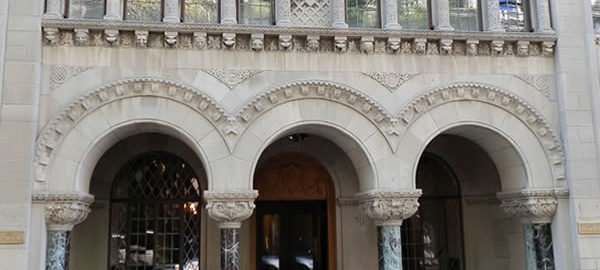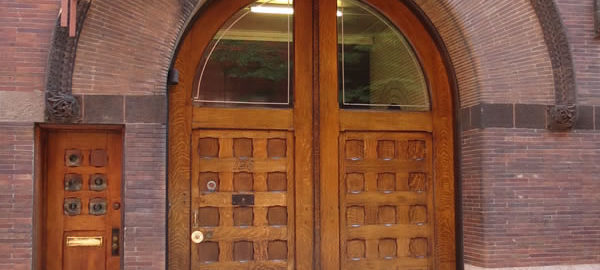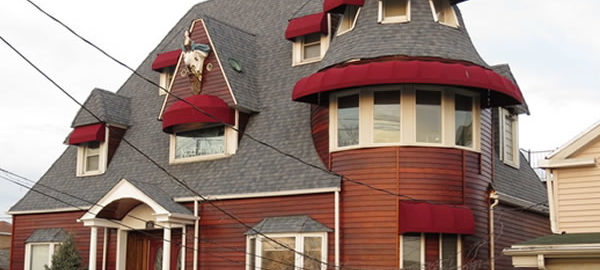NewYorkitecture.com is intended as a recreational site – exploring the city’s buildings, parks and infrastructure just for the fun of it. But lots of people have been documenting the same subject for years, with more serious intent. So, if you want to dig deeper (metaphorically, or course) into New York City Architecture, here are some excellent Internet resources:
NYC Landmarks Preservation Commission: www.nyc.gov/html/lpc/html/home/home.shtml
If you’re interested in classic architecture, “they don’t build ‘em like this anymore” structures, here’s your shortcut to finding them. The NYC Landmarks Preservation Commission “is responsible for identifying and designating the City’s landmarks and the buildings in the City’s historic districts. The Commission also regulates changes to designated buildings.”
The commission has a handy Glossary of Architectural Terms – www.nyc.gov/html/lpc/html/glossary/glossary.shtml – just in case I throw out some obscure term without explaining it (shame on me!).
City Realty: Cityrealty.com
I discovered this site by fortunate accident, while researching some addresses along Riverside Drive. Typing the address or building name in Google almost always returned references to CityRealty.com – which had detailed reports on the building in question. Architectural style, architect, year built, number of floors, famous residents, etc. Even architectural ratings and reviews!
Their secret is Carter B. Horsley, who spent 36 years as a reporter/editor covering architecture and real estate for The New York Times and The New York Post.
SkyscraperPage.com: Skyscraperpage.com
If you love skyscrapers, you’ll love this site! They have a huge database of skyscrapers around the world, including interactive maps, illustrations and fact sheets. And check out their store, for one-of-a-kind puzzles and posters. Check out their interactive NYC map: skyscraperpage.com/cities/maps/?cityID=8
NewYorkArchitecture.info: www.newyorkarchitecture.info/
NewYorkArchitecture.info is aimed more at people who are in the trade – architects, contractors, realtors, etc. Includes news and progress reports for new construction in the city.
GlassSteelAndStone.com: www.glasssteelandstone.com/
Glass Steel and Stone is another site for building trade professionals, but with a global perspective – you can check on buildings around the world.
Museum of the City of New York: www.mcny.org/
The Museum of the City of New York covers all things New York – with significant exhibitions on architecture and city planning. The museum also has lectures and tours to complement the exhibits – check and book early, they sell out quickly.
NYC-Architecture.com: nyc-architecture.com/
nyc-architecture.com contains news and reviews of historic and contemporary buildings of note, with archives by architectural style and building types (among other categories).
Buildipedia.com: Buildipedia.com
This is another building trades website, where you can become immersed in architecture’s state of the art – trends, best practices, etc., plus news of who’s building what, and where.
Emporis.com: emporis.com/city/newyorkcity-ny-usa
Emporis (formerly skyscrapers.com) is a global buildings database company – listing 403,420 buildings in 190 countries. If you have the name and/or address of a specific structure, you’ll find not only the architects, but also the engineers, suppliers, and contractors involved; when construction started and finished; the construction type, architectural style, height, number of floors, intended use – and photos. The link above brings you to the New York City page.
Wikimapia.org: wikimapia.org/#lat=40.7048512&lon=-74.0117115&z=18&l=0&m=b
This site is a Google map mashup that gives you building-by-building details for many of the city’s historic (and some not-historic) districts. Zoom in to see individual building outlines, traced around Google satellite images; click for building details, which often includes history, statistics, photos and links to the emporis.com database and/or Wikipedia. Amazing site, highly recommended. The link above puts you right into the heart of the Financial District.
Columbia University – Avery Architectural and Fine Arts Library: library.columbia.edu/indiv/avery/guides/nycbuild.html
This is a site devoted to researching New York City Buildings. For the serious architectural scholar or historian.

![Western Queens: Q001 [] Western Queens: Q001 []](https://www.newyorkitecture.com/wp-content/gallery/western-queens/Q001.jpg)
![Western Queens: Q002 [] Western Queens: Q002 []](https://www.newyorkitecture.com/wp-content/gallery/western-queens/Q002.jpg)
![Western Queens: Q003 [] Western Queens: Q003 []](https://www.newyorkitecture.com/wp-content/gallery/western-queens/Q003.jpg)
![Western Queens: Q004 [] Western Queens: Q004 []](https://www.newyorkitecture.com/wp-content/gallery/western-queens/Q004.jpg)
![Western Queens: Q005 [] Western Queens: Q005 []](https://www.newyorkitecture.com/wp-content/gallery/western-queens/Q005.jpg)
![Western Queens: Q006 [] Western Queens: Q006 []](https://www.newyorkitecture.com/wp-content/gallery/western-queens/Q006.jpg)
![Western Queens: Q007 [] Western Queens: Q007 []](https://www.newyorkitecture.com/wp-content/gallery/western-queens/Q007.jpg)
![Western Queens: Q007r [] Western Queens: Q007r []](https://www.newyorkitecture.com/wp-content/gallery/western-queens/Q007r.jpg)
![Western Queens: Q008 [] Western Queens: Q008 []](https://www.newyorkitecture.com/wp-content/gallery/western-queens/Q008.jpg)
![Western Queens: Q009 [] Western Queens: Q009 []](https://www.newyorkitecture.com/wp-content/gallery/western-queens/Q009.jpg)
![Western Queens: Q010 [] Western Queens: Q010 []](https://www.newyorkitecture.com/wp-content/gallery/western-queens/Q010.jpg)
![Western Queens: Q011 [] Western Queens: Q011 []](https://www.newyorkitecture.com/wp-content/gallery/western-queens/Q011.jpg)
![Western Queens: Q012 [] Western Queens: Q012 []](https://www.newyorkitecture.com/wp-content/gallery/western-queens/Q012.jpg)
![Western Queens: Q013 [] Western Queens: Q013 []](https://www.newyorkitecture.com/wp-content/gallery/western-queens/Q013.jpg)
![Western Queens: Q014 [] Western Queens: Q014 []](https://www.newyorkitecture.com/wp-content/gallery/western-queens/Q014.jpg)
![Western Queens: Q015 [] Western Queens: Q015 []](https://www.newyorkitecture.com/wp-content/gallery/western-queens/Q015.jpg)
![Western Queens: Q016 [] Western Queens: Q016 []](https://www.newyorkitecture.com/wp-content/gallery/western-queens/Q016.jpg)
![Western Queens: Q017 [] Western Queens: Q017 []](https://www.newyorkitecture.com/wp-content/gallery/western-queens/Q017.jpg)
![Western Queens: Q018 [] Western Queens: Q018 []](https://www.newyorkitecture.com/wp-content/gallery/western-queens/Q018.jpg)
![Western Queens: Q019 [] Western Queens: Q019 []](https://www.newyorkitecture.com/wp-content/gallery/western-queens/Q019.jpg)
![Western Queens: Q020 [] Western Queens: Q020 []](https://www.newyorkitecture.com/wp-content/gallery/western-queens/Q020.jpg)
![Western Queens: Q021 [] Western Queens: Q021 []](https://www.newyorkitecture.com/wp-content/gallery/western-queens/Q021.jpg)
![Western Queens: Q022 [] Western Queens: Q022 []](https://www.newyorkitecture.com/wp-content/gallery/western-queens/Q022.jpg)
![Western Queens: Q023 [] Western Queens: Q023 []](https://www.newyorkitecture.com/wp-content/gallery/western-queens/Q023.jpg)
![Western Queens: Q024 [] Western Queens: Q024 []](https://www.newyorkitecture.com/wp-content/gallery/western-queens/Q024.jpg)
![Western Queens: Q025 [] Western Queens: Q025 []](https://www.newyorkitecture.com/wp-content/gallery/western-queens/Q025.jpg)
![Western Queens: Q026 [] Western Queens: Q026 []](https://www.newyorkitecture.com/wp-content/gallery/western-queens/Q026.jpg)
![Western Queens: Q027 [] Western Queens: Q027 []](https://www.newyorkitecture.com/wp-content/gallery/western-queens/Q027.jpg)
![Western Queens: Q028 [] Western Queens: Q028 []](https://www.newyorkitecture.com/wp-content/gallery/western-queens/Q028.jpg)
![Western Queens: Q029 [] Western Queens: Q029 []](https://www.newyorkitecture.com/wp-content/gallery/western-queens/Q029.jpg)
![Western Queens: Q030 [] Western Queens: Q030 []](https://www.newyorkitecture.com/wp-content/gallery/western-queens/Q030.jpg)
![Western Queens: Q031 [] Western Queens: Q031 []](https://www.newyorkitecture.com/wp-content/gallery/western-queens/Q031.jpg)
![Western Queens: Q032 [] Western Queens: Q032 []](https://www.newyorkitecture.com/wp-content/gallery/western-queens/Q032.jpg)
![Western Queens: Q033 [] Western Queens: Q033 []](https://www.newyorkitecture.com/wp-content/gallery/western-queens/Q033.jpg)
![Western Queens: Q034 [] Western Queens: Q034 []](https://www.newyorkitecture.com/wp-content/gallery/western-queens/Q034.jpg)
![Western Queens: Q035 [] Western Queens: Q035 []](https://www.newyorkitecture.com/wp-content/gallery/western-queens/Q035.jpg)
![Western Queens: Q036 [] Western Queens: Q036 []](https://www.newyorkitecture.com/wp-content/gallery/western-queens/Q036.jpg)
![Western Queens: Q037 [] Western Queens: Q037 []](https://www.newyorkitecture.com/wp-content/gallery/western-queens/Q037.jpg)
![Western Queens: Q038 [] Western Queens: Q038 []](https://www.newyorkitecture.com/wp-content/gallery/western-queens/Q038.jpg)
![Western Queens: Q039 [] Western Queens: Q039 []](https://www.newyorkitecture.com/wp-content/gallery/western-queens/Q039.jpg)
![Western Queens: Q040 [] Western Queens: Q040 []](https://www.newyorkitecture.com/wp-content/gallery/western-queens/Q040.jpg)
![Western Queens: Q041 [] Western Queens: Q041 []](https://www.newyorkitecture.com/wp-content/gallery/western-queens/Q041.jpg)
![Western Queens: Q042 [] Western Queens: Q042 []](https://www.newyorkitecture.com/wp-content/gallery/western-queens/Q042.jpg)
![Western Queens: Q043 [] Western Queens: Q043 []](https://www.newyorkitecture.com/wp-content/gallery/western-queens/Q043.jpg)
![Western Queens: Q044 [] Western Queens: Q044 []](https://www.newyorkitecture.com/wp-content/gallery/western-queens/Q044.jpg)

![Doors of Brooklyn: d10 [] Doors of Brooklyn: d10 []](https://www.newyorkitecture.com/wp-content/gallery/doors-of-brooklyn/d10.jpg)
![Doors of Brooklyn: d01 [] Doors of Brooklyn: d01 []](https://www.newyorkitecture.com/wp-content/gallery/doors-of-brooklyn/d01.jpg)
![Doors of Brooklyn: d02 [] Doors of Brooklyn: d02 []](https://www.newyorkitecture.com/wp-content/gallery/doors-of-brooklyn/d02.jpg)
![Doors of Brooklyn: d03 [] Doors of Brooklyn: d03 []](https://www.newyorkitecture.com/wp-content/gallery/doors-of-brooklyn/d03.jpg)
![Doors of Brooklyn: d04 [] Doors of Brooklyn: d04 []](https://www.newyorkitecture.com/wp-content/gallery/doors-of-brooklyn/d04.jpg)
![Doors of Brooklyn: d05 [] Doors of Brooklyn: d05 []](https://www.newyorkitecture.com/wp-content/gallery/doors-of-brooklyn/d05.jpg)
![Doors of Brooklyn: d06 [] Doors of Brooklyn: d06 []](https://www.newyorkitecture.com/wp-content/gallery/doors-of-brooklyn/d06.jpg)
![Doors of Brooklyn: d07 [] Doors of Brooklyn: d07 []](https://www.newyorkitecture.com/wp-content/gallery/doors-of-brooklyn/d07.jpg)
![Doors of Brooklyn: d08 [] Doors of Brooklyn: d08 []](https://www.newyorkitecture.com/wp-content/gallery/doors-of-brooklyn/d08.jpg)
![Doors of Brooklyn: d09 [] Doors of Brooklyn: d09 []](https://www.newyorkitecture.com/wp-content/gallery/doors-of-brooklyn/d09.jpg)
![Doors of Brooklyn: d11 [] Doors of Brooklyn: d11 []](https://www.newyorkitecture.com/wp-content/gallery/doors-of-brooklyn/d11.jpg)
![Doors of Brooklyn: d12 [] Doors of Brooklyn: d12 []](https://www.newyorkitecture.com/wp-content/gallery/doors-of-brooklyn/d12.jpg)
![Doors of Brooklyn: d13 [] Doors of Brooklyn: d13 []](https://www.newyorkitecture.com/wp-content/gallery/doors-of-brooklyn/d13.jpg)
![Doors of Brooklyn: d14 [] Doors of Brooklyn: d14 []](https://www.newyorkitecture.com/wp-content/gallery/doors-of-brooklyn/d14.jpg)
![Doors of Brooklyn: d15 [] Doors of Brooklyn: d15 []](https://www.newyorkitecture.com/wp-content/gallery/doors-of-brooklyn/d15.jpg)
![Doors of Brooklyn: d16 [] Doors of Brooklyn: d16 []](https://www.newyorkitecture.com/wp-content/gallery/doors-of-brooklyn/d16.jpg)
![Doors of Brooklyn: d17 [] Doors of Brooklyn: d17 []](https://www.newyorkitecture.com/wp-content/gallery/doors-of-brooklyn/d17.jpg)
![Doors of Brooklyn: d18 [] Doors of Brooklyn: d18 []](https://www.newyorkitecture.com/wp-content/gallery/doors-of-brooklyn/d18.jpg)
![Doors of Brooklyn: d19 [] Doors of Brooklyn: d19 []](https://www.newyorkitecture.com/wp-content/gallery/doors-of-brooklyn/d19.jpg)
![Doors of Brooklyn: d20 [] Doors of Brooklyn: d20 []](https://www.newyorkitecture.com/wp-content/gallery/doors-of-brooklyn/d20.jpg)
![Doors of Brooklyn: d21 [] Doors of Brooklyn: d21 []](https://www.newyorkitecture.com/wp-content/gallery/doors-of-brooklyn/d21.jpg)
![Doors of Brooklyn: d22 [] Doors of Brooklyn: d22 []](https://www.newyorkitecture.com/wp-content/gallery/doors-of-brooklyn/d22.jpg)
![Doors of Brooklyn: d23 [] Doors of Brooklyn: d23 []](https://www.newyorkitecture.com/wp-content/gallery/doors-of-brooklyn/d23.jpg)
![Doors of Brooklyn: d24 [] Doors of Brooklyn: d24 []](https://www.newyorkitecture.com/wp-content/gallery/doors-of-brooklyn/d24.jpg)
![Doors of Brooklyn: d25 [] Doors of Brooklyn: d25 []](https://www.newyorkitecture.com/wp-content/gallery/doors-of-brooklyn/d25.jpg)
![Doors of Brooklyn: d26 [] Doors of Brooklyn: d26 []](https://www.newyorkitecture.com/wp-content/gallery/doors-of-brooklyn/d26.jpg)
![Doors of Brooklyn: d27 [] Doors of Brooklyn: d27 []](https://www.newyorkitecture.com/wp-content/gallery/doors-of-brooklyn/d27.jpg)
![Doors of Brooklyn: d28 [] Doors of Brooklyn: d28 []](https://www.newyorkitecture.com/wp-content/gallery/doors-of-brooklyn/d28.jpg)
![Doors of Brooklyn: d29 [] Doors of Brooklyn: d29 []](https://www.newyorkitecture.com/wp-content/gallery/doors-of-brooklyn/d29.jpg)
![Doors of Brooklyn: d30 [] Doors of Brooklyn: d30 []](https://www.newyorkitecture.com/wp-content/gallery/doors-of-brooklyn/d30.jpg)
![Doors of Brooklyn: d31 [] Doors of Brooklyn: d31 []](https://www.newyorkitecture.com/wp-content/gallery/doors-of-brooklyn/d31.jpg)
![Doors of Brooklyn: d32 [] Doors of Brooklyn: d32 []](https://www.newyorkitecture.com/wp-content/gallery/doors-of-brooklyn/d32.jpg)
![Doors of Brooklyn: d33 [] Doors of Brooklyn: d33 []](https://www.newyorkitecture.com/wp-content/gallery/doors-of-brooklyn/d33.jpg)
![Doors of Brooklyn: d34 [] Doors of Brooklyn: d34 []](https://www.newyorkitecture.com/wp-content/gallery/doors-of-brooklyn/d34.jpg)
![Doors of Brooklyn: d35 [] Doors of Brooklyn: d35 []](https://www.newyorkitecture.com/wp-content/gallery/doors-of-brooklyn/d35.jpg)
![Doors of Brooklyn: d36 [] Doors of Brooklyn: d36 []](https://www.newyorkitecture.com/wp-content/gallery/doors-of-brooklyn/d36.jpg)
![Doors of Brooklyn: d37 [] Doors of Brooklyn: d37 []](https://www.newyorkitecture.com/wp-content/gallery/doors-of-brooklyn/d37.jpg)
![Doors of Brooklyn: d38 [] Doors of Brooklyn: d38 []](https://www.newyorkitecture.com/wp-content/gallery/doors-of-brooklyn/d38.jpg)
![Doors of Brooklyn: d39 [] Doors of Brooklyn: d39 []](https://www.newyorkitecture.com/wp-content/gallery/doors-of-brooklyn/d39.jpg)
![Doors of Brooklyn: d42 [] Doors of Brooklyn: d42 []](https://www.newyorkitecture.com/wp-content/gallery/doors-of-brooklyn/d42.jpg)
![Doors of Brooklyn: d43 [] Doors of Brooklyn: d43 []](https://www.newyorkitecture.com/wp-content/gallery/doors-of-brooklyn/d43.jpg)
![Doors of Brooklyn: d44 [] Doors of Brooklyn: d44 []](https://www.newyorkitecture.com/wp-content/gallery/doors-of-brooklyn/d44.jpg)
![Doors of Brooklyn: d45 [] Doors of Brooklyn: d45 []](https://www.newyorkitecture.com/wp-content/gallery/doors-of-brooklyn/d45.jpg)
![Doors of Brooklyn: d46 [] Doors of Brooklyn: d46 []](https://www.newyorkitecture.com/wp-content/gallery/doors-of-brooklyn/d46.jpg)
![Doors of Brooklyn: d47 [] Doors of Brooklyn: d47 []](https://www.newyorkitecture.com/wp-content/gallery/doors-of-brooklyn/d47.jpg)

![Faces of Manhattan: Face01 [] Faces of Manhattan: Face01 []](https://www.newyorkitecture.com/wp-content/gallery/faces-of-manhattan/Face01.jpg)
![Faces of Manhattan: Face02 [] Faces of Manhattan: Face02 []](https://www.newyorkitecture.com/wp-content/gallery/faces-of-manhattan/Face02.jpg)
![Faces of Manhattan: Face03 [] Faces of Manhattan: Face03 []](https://www.newyorkitecture.com/wp-content/gallery/faces-of-manhattan/Face03.jpg)
![Faces of Manhattan: Face04 [] Faces of Manhattan: Face04 []](https://www.newyorkitecture.com/wp-content/gallery/faces-of-manhattan/Face04.jpg)
![Faces of Manhattan: Face05 [] Faces of Manhattan: Face05 []](https://www.newyorkitecture.com/wp-content/gallery/faces-of-manhattan/Face05.jpg)
![Faces of Manhattan: Face06 [] Faces of Manhattan: Face06 []](https://www.newyorkitecture.com/wp-content/gallery/faces-of-manhattan/Face06.jpg)
![Faces of Manhattan: Face07 [] Faces of Manhattan: Face07 []](https://www.newyorkitecture.com/wp-content/gallery/faces-of-manhattan/Face07.jpg)
![Faces of Manhattan: Face08 [] Faces of Manhattan: Face08 []](https://www.newyorkitecture.com/wp-content/gallery/faces-of-manhattan/Face08.jpg)
![Faces of Manhattan: Face09 [] Faces of Manhattan: Face09 []](https://www.newyorkitecture.com/wp-content/gallery/faces-of-manhattan/Face09.jpg)
![Faces of Manhattan: Face10 [] Faces of Manhattan: Face10 []](https://www.newyorkitecture.com/wp-content/gallery/faces-of-manhattan/Face10.jpg)
![Faces of Manhattan: Face11 [] Faces of Manhattan: Face11 []](https://www.newyorkitecture.com/wp-content/gallery/faces-of-manhattan/Face11.jpg)
![Faces of Manhattan: Face12 [] Faces of Manhattan: Face12 []](https://www.newyorkitecture.com/wp-content/gallery/faces-of-manhattan/Face12.jpg)
![Faces of Manhattan: Face13 [] Faces of Manhattan: Face13 []](https://www.newyorkitecture.com/wp-content/gallery/faces-of-manhattan/Face13.jpg)
![Faces of Manhattan: Face14 [] Faces of Manhattan: Face14 []](https://www.newyorkitecture.com/wp-content/gallery/faces-of-manhattan/Face14.jpg)
![Faces of Manhattan: Face15 [] Faces of Manhattan: Face15 []](https://www.newyorkitecture.com/wp-content/gallery/faces-of-manhattan/Face15.jpg)
![Faces of Manhattan: Face16 [] Faces of Manhattan: Face16 []](https://www.newyorkitecture.com/wp-content/gallery/faces-of-manhattan/Face16.jpg)
![Faces of Manhattan: Face17 [] Faces of Manhattan: Face17 []](https://www.newyorkitecture.com/wp-content/gallery/faces-of-manhattan/Face17.jpg)
![Faces of Manhattan: Face18 [] Faces of Manhattan: Face18 []](https://www.newyorkitecture.com/wp-content/gallery/faces-of-manhattan/Face18.jpg)
![Faces of Manhattan: Face27 [] Faces of Manhattan: Face27 []](https://www.newyorkitecture.com/wp-content/gallery/faces-of-manhattan/Face27.jpg)
![Faces of Manhattan: Face28 [] Faces of Manhattan: Face28 []](https://www.newyorkitecture.com/wp-content/gallery/faces-of-manhattan/Face28.jpg)
![Faces of Manhattan: Face30 [] Faces of Manhattan: Face30 []](https://www.newyorkitecture.com/wp-content/gallery/faces-of-manhattan/Face30.jpg)
![Faces of Manhattan: Face31 [] Faces of Manhattan: Face31 []](https://www.newyorkitecture.com/wp-content/gallery/faces-of-manhattan/Face31.jpg)
![Faces of Manhattan: Face32 [] Faces of Manhattan: Face32 []](https://www.newyorkitecture.com/wp-content/gallery/faces-of-manhattan/Face32.jpg)
![Faces of Manhattan: Face33 [] Faces of Manhattan: Face33 []](https://www.newyorkitecture.com/wp-content/gallery/faces-of-manhattan/Face33.jpg)
![Faces of Manhattan: Face34 [] Faces of Manhattan: Face34 []](https://www.newyorkitecture.com/wp-content/gallery/faces-of-manhattan/Face34.jpg)
![Faces of Manhattan: Face35 [] Faces of Manhattan: Face35 []](https://www.newyorkitecture.com/wp-content/gallery/faces-of-manhattan/Face35.jpg)
![Faces of Manhattan: Face36 [] Faces of Manhattan: Face36 []](https://www.newyorkitecture.com/wp-content/gallery/faces-of-manhattan/Face36.jpg)
![Faces of Manhattan: Face37 [] Faces of Manhattan: Face37 []](https://www.newyorkitecture.com/wp-content/gallery/faces-of-manhattan/Face37.jpg)
![Faces of Manhattan: Face38 [] Faces of Manhattan: Face38 []](https://www.newyorkitecture.com/wp-content/gallery/faces-of-manhattan/Face38.jpg)
![Faces of Manhattan: Face39 [] Faces of Manhattan: Face39 []](https://www.newyorkitecture.com/wp-content/gallery/faces-of-manhattan/Face39.jpg)
![Faces of Manhattan: Face40 [] Faces of Manhattan: Face40 []](https://www.newyorkitecture.com/wp-content/gallery/faces-of-manhattan/Face40.jpg)
![Faces of Manhattan: Face41 [] Faces of Manhattan: Face41 []](https://www.newyorkitecture.com/wp-content/gallery/faces-of-manhattan/Face41.jpg)
![Faces of Manhattan: Face42 [] Faces of Manhattan: Face42 []](https://www.newyorkitecture.com/wp-content/gallery/faces-of-manhattan/Face42.jpg)
![Faces of Manhattan: Face43 [] Faces of Manhattan: Face43 []](https://www.newyorkitecture.com/wp-content/gallery/faces-of-manhattan/Face43.jpg)
![Faces of Manhattan: Face44 [] Faces of Manhattan: Face44 []](https://www.newyorkitecture.com/wp-content/gallery/faces-of-manhattan/Face44.jpg)
![Faces of Manhattan: Face45 [] Faces of Manhattan: Face45 []](https://www.newyorkitecture.com/wp-content/gallery/faces-of-manhattan/Face45.jpg)
![Faces of Manhattan: Face46 [] Faces of Manhattan: Face46 []](https://www.newyorkitecture.com/wp-content/gallery/faces-of-manhattan/Face46.jpg)
![Faces of Manhattan: Face47 [] Faces of Manhattan: Face47 []](https://www.newyorkitecture.com/wp-content/gallery/faces-of-manhattan/Face47.jpg)
![Faces of Manhattan: Face48 [] Faces of Manhattan: Face48 []](https://www.newyorkitecture.com/wp-content/gallery/faces-of-manhattan/Face48.jpg)
![Faces of Manhattan: Face49 [] Faces of Manhattan: Face49 []](https://www.newyorkitecture.com/wp-content/gallery/faces-of-manhattan/Face49.jpg)
![Faces of Manhattan: Face50 [] Faces of Manhattan: Face50 []](https://www.newyorkitecture.com/wp-content/gallery/faces-of-manhattan/Face50.jpg)
![Faces of Manhattan: Face51 [] Faces of Manhattan: Face51 []](https://www.newyorkitecture.com/wp-content/gallery/faces-of-manhattan/Face51.jpg)
![Faces of Manhattan: Face52 [] Faces of Manhattan: Face52 []](https://www.newyorkitecture.com/wp-content/gallery/faces-of-manhattan/Face52.jpg)
![Faces of Manhattan: Face53 [] Faces of Manhattan: Face53 []](https://www.newyorkitecture.com/wp-content/gallery/faces-of-manhattan/Face53.jpg)
![Faces of Manhattan: Face54 [] Faces of Manhattan: Face54 []](https://www.newyorkitecture.com/wp-content/gallery/faces-of-manhattan/Face54.jpg)
![Faces of Manhattan: Face55 [] Faces of Manhattan: Face55 []](https://www.newyorkitecture.com/wp-content/gallery/faces-of-manhattan/Face55.jpg)

![Doors of Manhattan: d60 [] Doors of Manhattan: d60 []](https://www.newyorkitecture.com/wp-content/gallery/doors-of-manhattan-3/d60.jpg)
![Doors of Manhattan: d51 [] Doors of Manhattan: d51 []](https://www.newyorkitecture.com/wp-content/gallery/doors-of-manhattan-3/d51.jpg)
![Doors of Manhattan: d48 [] Doors of Manhattan: d48 []](https://www.newyorkitecture.com/wp-content/gallery/doors-of-manhattan-3/d48.jpg)
![Doors of Manhattan: d70 [] Doors of Manhattan: d70 []](https://www.newyorkitecture.com/wp-content/gallery/doors-of-manhattan-3/d70.jpg)
![Doors of Manhattan: d69 [] Doors of Manhattan: d69 []](https://www.newyorkitecture.com/wp-content/gallery/doors-of-manhattan-3/d69.jpg)
![Doors of Manhattan: d68 [] Doors of Manhattan: d68 []](https://www.newyorkitecture.com/wp-content/gallery/doors-of-manhattan-3/d68.jpg)
![Doors of Manhattan: d67 [] Doors of Manhattan: d67 []](https://www.newyorkitecture.com/wp-content/gallery/doors-of-manhattan-3/d67.jpg)
![Doors of Manhattan: d66 [] Doors of Manhattan: d66 []](https://www.newyorkitecture.com/wp-content/gallery/doors-of-manhattan-3/d66.jpg)
![Doors of Manhattan: d65 [] Doors of Manhattan: d65 []](https://www.newyorkitecture.com/wp-content/gallery/doors-of-manhattan-3/d65.jpg)
![Doors of Manhattan: d64 [] Doors of Manhattan: d64 []](https://www.newyorkitecture.com/wp-content/gallery/doors-of-manhattan-3/d64.jpg)
![Doors of Manhattan: d63 [] Doors of Manhattan: d63 []](https://www.newyorkitecture.com/wp-content/gallery/doors-of-manhattan-3/d63.jpg)
![Doors of Manhattan: d62 [] Doors of Manhattan: d62 []](https://www.newyorkitecture.com/wp-content/gallery/doors-of-manhattan-3/d62.jpg)
![Doors of Manhattan: d61 [] Doors of Manhattan: d61 []](https://www.newyorkitecture.com/wp-content/gallery/doors-of-manhattan-3/d61.jpg)
![Doors of Manhattan: d40 [] Doors of Manhattan: d40 []](https://www.newyorkitecture.com/wp-content/gallery/doors-of-manhattan-3/d40.jpg)
![Doors of Manhattan: d59 [] Doors of Manhattan: d59 []](https://www.newyorkitecture.com/wp-content/gallery/doors-of-manhattan-3/d59.jpg)
![Doors of Manhattan: d58 [] Doors of Manhattan: d58 []](https://www.newyorkitecture.com/wp-content/gallery/doors-of-manhattan-3/d58.jpg)
![Doors of Manhattan: d57 [] Doors of Manhattan: d57 []](https://www.newyorkitecture.com/wp-content/gallery/doors-of-manhattan-3/d57.jpg)
![Doors of Manhattan: d56 [] Doors of Manhattan: d56 []](https://www.newyorkitecture.com/wp-content/gallery/doors-of-manhattan-3/d56.jpg)
![Doors of Manhattan: d55 [] Doors of Manhattan: d55 []](https://www.newyorkitecture.com/wp-content/gallery/doors-of-manhattan-3/d55.jpg)
![Doors of Manhattan: d54 [] Doors of Manhattan: d54 []](https://www.newyorkitecture.com/wp-content/gallery/doors-of-manhattan-3/d54.jpg)
![Doors of Manhattan: d53 [] Doors of Manhattan: d53 []](https://www.newyorkitecture.com/wp-content/gallery/doors-of-manhattan-3/d53.jpg)
![Doors of Manhattan: d52 [] Doors of Manhattan: d52 []](https://www.newyorkitecture.com/wp-content/gallery/doors-of-manhattan-3/d52.jpg)
![Doors of Manhattan: d50 [] Doors of Manhattan: d50 []](https://www.newyorkitecture.com/wp-content/gallery/doors-of-manhattan-3/d50.jpg)
![Doors of Manhattan: d49 [] Doors of Manhattan: d49 []](https://www.newyorkitecture.com/wp-content/gallery/doors-of-manhattan-3/d49.jpg)
![Doors of Manhattan: d41 [] Doors of Manhattan: d41 []](https://www.newyorkitecture.com/wp-content/gallery/doors-of-manhattan-3/d41.jpg)


![IMG_5992_3_4Adjust [3/14/2012 2:30:07 PM] IMG_5992_3_4Adjust [3/14/2012 2:30:07 PM]](https://www.newyorkitecture.com/wp-content/gallery/new-york-is-looking-up/img_5992_3_4adjust.jpg)
![IMG_5995_6_7Adjust [3/14/2012 2:30:50 PM] IMG_5995_6_7Adjust [3/14/2012 2:30:50 PM]](https://www.newyorkitecture.com/wp-content/gallery/new-york-is-looking-up/img_5995_6_7adjust.jpg)
![IMG_09844_5_6Adjust [2/18/2012 1:39:07 PM] IMG_09844_5_6Adjust [2/18/2012 1:39:07 PM]](https://www.newyorkitecture.com/wp-content/gallery/new-york-is-looking-up/img_09844_5_6adjust.jpg)
![IMG_1699_700_701Adjust [2/27/2012 12:35:32 PM] IMG_1699_700_701Adjust [2/27/2012 12:35:32 PM]](https://www.newyorkitecture.com/wp-content/gallery/new-york-is-looking-up/img_1699_700_701adjust.jpg)
![IMG_0220_1_2Adjust [2/19/2012 12:14:37 PM] IMG_0220_1_2Adjust [2/19/2012 12:14:37 PM]](https://www.newyorkitecture.com/wp-content/gallery/new-york-is-looking-up/img_0220_1_2adjust.jpg)
![IMG_3856_7_8Adjust [3/9/2012 2:05:23 PM] IMG_3856_7_8Adjust [3/9/2012 2:05:23 PM]](https://www.newyorkitecture.com/wp-content/gallery/new-york-is-looking-up/img_3856_7_8adjust.jpg)
![IMG_3865_6_7Adjust [3/9/2012 2:06:51 PM] IMG_3865_6_7Adjust [3/9/2012 2:06:51 PM]](https://www.newyorkitecture.com/wp-content/gallery/new-york-is-looking-up/img_3865_6_7adjust.jpg)
![IMG_3889_90_91Adjust [3/9/2012 2:13:10 PM] IMG_3889_90_91Adjust [3/9/2012 2:13:10 PM]](https://www.newyorkitecture.com/wp-content/gallery/new-york-is-looking-up/img_3889_90_91adjust.jpg)

![[Fifth Avenue Swath] IMG_3291 [6/11/2012 11:11:14 AM] [Fifth Avenue Swath] IMG_3291 [6/11/2012 11:11:14 AM]](https://www.newyorkitecture.com/wp-content/gallery/clocks/img_3291_resize.jpg)
![Q027 [] Q027 []](https://www.newyorkitecture.com/wp-content/gallery/clocks/Q027.jpg)
![Q003 [] Q003 []](https://www.newyorkitecture.com/wp-content/gallery/clocks/Q003.jpg)
![IMG_6709_10_11Adjust [2/4/2012 11:46:24 AM] IMG_6709_10_11Adjust [2/4/2012 11:46:24 AM]](https://www.newyorkitecture.com/wp-content/gallery/clocks/img_6709_10_11adjust.jpg)
![IMG_4645_6_7Adjust [3/12/2012 8:18:10 AM] IMG_4645_6_7Adjust [3/12/2012 8:18:10 AM]](https://www.newyorkitecture.com/wp-content/gallery/clocks/img_4645_6_7adjust.jpg)
![[Fifth Avenue Swath] IMG_3332 [6/11/2012 11:19:51 AM] [Fifth Avenue Swath] IMG_3332 [6/11/2012 11:19:51 AM]](https://www.newyorkitecture.com/wp-content/gallery/clocks/img_3332_resize.jpg)
![[Fifth Avenue Swath] IMG_3277 [6/11/2012 11:07:36 AM] [Fifth Avenue Swath] IMG_3277 [6/11/2012 11:07:36 AM]](https://www.newyorkitecture.com/wp-content/gallery/clocks/img_3277_resize.jpg)
![[Fifth Avenue Swath] IMG_3216 [6/11/2012 10:47:44 AM] [Fifth Avenue Swath] IMG_3216 [6/11/2012 10:47:44 AM]](https://www.newyorkitecture.com/wp-content/gallery/clocks/img_3216_resize.jpg)
![[Fifth Avenue Swath] IMG_3166 [6/11/2012 10:30:29 AM] [Fifth Avenue Swath] IMG_3166 [6/11/2012 10:30:29 AM]](https://www.newyorkitecture.com/wp-content/gallery/clocks/img_3166_resize.jpg)
![[Fifth Avenue Swath] IMG_3140 [6/11/2012 10:16:59 AM] [Fifth Avenue Swath] IMG_3140 [6/11/2012 10:16:59 AM]](https://www.newyorkitecture.com/wp-content/gallery/clocks/img_3140_resize.jpg)
![[Fifth Avenue Swath] IMG_3023 [6/11/2012 9:18:26 AM] [Fifth Avenue Swath] IMG_3023 [6/11/2012 9:18:26 AM]](https://www.newyorkitecture.com/wp-content/gallery/clocks/img_3023_resize.jpg)
![IMG_2794_5_6Adjust [3/7/2012 9:31:51 AM] IMG_2794_5_6Adjust [3/7/2012 9:31:51 AM]](https://www.newyorkitecture.com/wp-content/gallery/clocks/img_2794_5_6adjust.jpg)
![IMG_1297 [12/1/2011 4:00:30 PM] IMG_1297 [12/1/2011 4:00:30 PM]](https://www.newyorkitecture.com/wp-content/gallery/clocks/img_1297.jpg)
![IMG_0974 [12/1/2011 2:29:04 PM] IMG_0974 [12/1/2011 2:29:04 PM]](https://www.newyorkitecture.com/wp-content/gallery/clocks/img_0974.jpg)
![IMG_0971 [12/1/2011 2:28:44 PM] IMG_0971 [12/1/2011 2:28:44 PM]](https://www.newyorkitecture.com/wp-content/gallery/clocks/img_0971.jpg)
![IMG_0790_1_2Adjust [2/20/2012 11:37:07 AM] IMG_0790_1_2Adjust [2/20/2012 11:37:07 AM]](https://www.newyorkitecture.com/wp-content/gallery/clocks/img_0790_1_2adjust.jpg)
![IMG_0649a [] IMG_0649a []](https://www.newyorkitecture.com/wp-content/gallery/clocks/img_0649a.jpg)










![IMG_9698 [11/27/2011 3:03:42 PM] IMG_9698 [11/27/2011 3:03:42 PM]](https://www.newyorkitecture.com/wp-content/gallery/city-island/img_9698.jpg)
![IMG_9733 [11/27/2011 3:37:27 PM] IMG_9733 [11/27/2011 3:37:27 PM]](https://www.newyorkitecture.com/wp-content/gallery/city-island/img_9733.jpg)
![IMG_9727 [11/27/2011 3:25:06 PM] IMG_9727 [11/27/2011 3:25:06 PM]](https://www.newyorkitecture.com/wp-content/gallery/city-island/img_9727.jpg)
![IMG_9719 [11/27/2011 3:21:49 PM] IMG_9719 [11/27/2011 3:21:49 PM]](https://www.newyorkitecture.com/wp-content/gallery/city-island/img_9719.jpg)
![IMG_9716 [11/27/2011 3:21:34 PM] IMG_9716 [11/27/2011 3:21:34 PM]](https://www.newyorkitecture.com/wp-content/gallery/city-island/img_9716.jpg)
![IMG_9710 [11/27/2011 3:18:32 PM] IMG_9710 [11/27/2011 3:18:32 PM]](https://www.newyorkitecture.com/wp-content/gallery/city-island/img_9710.jpg)
![IMG_9707 [11/27/2011 3:16:04 PM] IMG_9707 [11/27/2011 3:16:04 PM]](https://www.newyorkitecture.com/wp-content/gallery/city-island/img_9707.jpg)
![IMG_9704 [11/27/2011 3:15:13 PM] IMG_9704 [11/27/2011 3:15:13 PM]](https://www.newyorkitecture.com/wp-content/gallery/city-island/img_9704.jpg)
![IMG_9701 [11/27/2011 3:11:01 PM] IMG_9701 [11/27/2011 3:11:01 PM]](https://www.newyorkitecture.com/wp-content/gallery/city-island/img_9701.jpg)
![IMG_9743 [11/27/2011 4:31:58 PM] IMG_9743 [11/27/2011 4:31:58 PM]](https://www.newyorkitecture.com/wp-content/gallery/city-island/img_9743.jpg)
![IMG_9695 [11/27/2011 3:03:01 PM] IMG_9695 [11/27/2011 3:03:01 PM]](https://www.newyorkitecture.com/wp-content/gallery/city-island/img_9695.jpg)
![IMG_9686 [11/27/2011 3:01:20 PM] IMG_9686 [11/27/2011 3:01:20 PM]](https://www.newyorkitecture.com/wp-content/gallery/city-island/img_9686.jpg)
![IMG_9680 [11/27/2011 2:58:47 PM] IMG_9680 [11/27/2011 2:58:47 PM]](https://www.newyorkitecture.com/wp-content/gallery/city-island/img_9680.jpg)
![IMG_9656 [11/27/2011 2:42:02 PM] IMG_9656 [11/27/2011 2:42:02 PM]](https://www.newyorkitecture.com/wp-content/gallery/city-island/img_9656.jpg)
![IMG_9653 [11/27/2011 2:40:28 PM] IMG_9653 [11/27/2011 2:40:28 PM]](https://www.newyorkitecture.com/wp-content/gallery/city-island/img_9653.jpg)
![IMG_9650 [11/27/2011 2:40:09 PM] IMG_9650 [11/27/2011 2:40:09 PM]](https://www.newyorkitecture.com/wp-content/gallery/city-island/img_9650.jpg)
![IMG_9646 [11/27/2011 2:39:14 PM] IMG_9646 [11/27/2011 2:39:14 PM]](https://www.newyorkitecture.com/wp-content/gallery/city-island/img_9646.jpg)
![IMG_9794 [11/27/2011 4:51:15 PM] IMG_9794 [11/27/2011 4:51:15 PM]](https://www.newyorkitecture.com/wp-content/gallery/city-island/img_9794.jpg)
![IMG_9842 [11/27/2011 5:15:38 PM] IMG_9842 [11/27/2011 5:15:38 PM]](https://www.newyorkitecture.com/wp-content/gallery/city-island/img_9842.jpg)
![IMG_9839 [11/27/2011 5:13:17 PM] IMG_9839 [11/27/2011 5:13:17 PM]](https://www.newyorkitecture.com/wp-content/gallery/city-island/img_9839.jpg)
![IMG_9833 [11/27/2011 5:11:33 PM] IMG_9833 [11/27/2011 5:11:33 PM]](https://www.newyorkitecture.com/wp-content/gallery/city-island/img_9833.jpg)
![IMG_9830 [11/27/2011 5:10:49 PM] IMG_9830 [11/27/2011 5:10:49 PM]](https://www.newyorkitecture.com/wp-content/gallery/city-island/img_9830.jpg)
![IMG_9827 [11/27/2011 5:10:10 PM] IMG_9827 [11/27/2011 5:10:10 PM]](https://www.newyorkitecture.com/wp-content/gallery/city-island/img_9827.jpg)
![IMG_9822 [11/27/2011 4:56:10 PM] IMG_9822 [11/27/2011 4:56:10 PM]](https://www.newyorkitecture.com/wp-content/gallery/city-island/img_9822.jpg)
![IMG_9812 [11/27/2011 4:54:17 PM] IMG_9812 [11/27/2011 4:54:17 PM]](https://www.newyorkitecture.com/wp-content/gallery/city-island/img_9812.jpg)
![IMG_9801 [11/27/2011 4:51:56 PM] IMG_9801 [11/27/2011 4:51:56 PM]](https://www.newyorkitecture.com/wp-content/gallery/city-island/img_9801.jpg)
![IMG_9632 [11/27/2011 2:27:55 PM] IMG_9632 [11/27/2011 2:27:55 PM]](https://www.newyorkitecture.com/wp-content/gallery/city-island/img_9632.jpg)
![IMG_9789 [11/27/2011 4:50:29 PM] IMG_9789 [11/27/2011 4:50:29 PM]](https://www.newyorkitecture.com/wp-content/gallery/city-island/img_9789.jpg)
![IMG_9783 [11/27/2011 4:49:02 PM] IMG_9783 [11/27/2011 4:49:02 PM]](https://www.newyorkitecture.com/wp-content/gallery/city-island/img_9783.jpg)
![IMG_9779 [11/27/2011 4:47:47 PM] IMG_9779 [11/27/2011 4:47:47 PM]](https://www.newyorkitecture.com/wp-content/gallery/city-island/img_9779.jpg)
![IMG_9776 [11/27/2011 4:45:11 PM] IMG_9776 [11/27/2011 4:45:11 PM]](https://www.newyorkitecture.com/wp-content/gallery/city-island/img_9776.jpg)
![IMG_9769 [11/27/2011 4:43:54 PM] IMG_9769 [11/27/2011 4:43:54 PM]](https://www.newyorkitecture.com/wp-content/gallery/city-island/img_9769.jpg)
![IMG_9761 [11/27/2011 4:37:45 PM] IMG_9761 [11/27/2011 4:37:45 PM]](https://www.newyorkitecture.com/wp-content/gallery/city-island/img_9761.jpg)
![IMG_9757 [11/27/2011 4:36:31 PM] IMG_9757 [11/27/2011 4:36:31 PM]](https://www.newyorkitecture.com/wp-content/gallery/city-island/img_9757.jpg)
![IMG_9459 [11/27/2011 1:25:44 PM] IMG_9459 [11/27/2011 1:25:44 PM]](https://www.newyorkitecture.com/wp-content/gallery/city-island/img_9459.jpg)
![IMG_9510 [11/27/2011 1:42:37 PM] IMG_9510 [11/27/2011 1:42:37 PM]](https://www.newyorkitecture.com/wp-content/gallery/city-island/img_9510.jpg)
![IMG_9501 [11/27/2011 1:41:23 PM] IMG_9501 [11/27/2011 1:41:23 PM]](https://www.newyorkitecture.com/wp-content/gallery/city-island/img_9501.jpg)
![IMG_9497 [11/27/2011 1:41:00 PM] IMG_9497 [11/27/2011 1:41:00 PM]](https://www.newyorkitecture.com/wp-content/gallery/city-island/img_9497.jpg)
![IMG_9495 [11/27/2011 1:36:48 PM] IMG_9495 [11/27/2011 1:36:48 PM]](https://www.newyorkitecture.com/wp-content/gallery/city-island/img_9495.jpg)
![IMG_9485 [11/27/2011 1:32:33 PM] IMG_9485 [11/27/2011 1:32:33 PM]](https://www.newyorkitecture.com/wp-content/gallery/city-island/img_9485.jpg)
![IMG_9482 [11/27/2011 1:31:46 PM] IMG_9482 [11/27/2011 1:31:46 PM]](https://www.newyorkitecture.com/wp-content/gallery/city-island/img_9482.jpg)
![IMG_9470 [11/27/2011 1:28:08 PM] IMG_9470 [11/27/2011 1:28:08 PM]](https://www.newyorkitecture.com/wp-content/gallery/city-island/img_9470.jpg)
![IMG_9467 [11/27/2011 1:27:33 PM] IMG_9467 [11/27/2011 1:27:33 PM]](https://www.newyorkitecture.com/wp-content/gallery/city-island/img_9467.jpg)
![IMG_9521 [11/27/2011 1:44:42 PM] IMG_9521 [11/27/2011 1:44:42 PM]](https://www.newyorkitecture.com/wp-content/gallery/city-island/img_9521.jpg)
![IMG_9452 [11/27/2011 1:24:52 PM] IMG_9452 [11/27/2011 1:24:52 PM]](https://www.newyorkitecture.com/wp-content/gallery/city-island/img_9452.jpg)
![IMG_9447 [11/27/2011 1:20:27 PM] IMG_9447 [11/27/2011 1:20:27 PM]](https://www.newyorkitecture.com/wp-content/gallery/city-island/img_9447.jpg)
![IMG_9437 [11/27/2011 1:18:09 PM] IMG_9437 [11/27/2011 1:18:09 PM]](https://www.newyorkitecture.com/wp-content/gallery/city-island/img_9437.jpg)
![IMG_9433 [11/27/2011 1:15:53 PM] IMG_9433 [11/27/2011 1:15:53 PM]](https://www.newyorkitecture.com/wp-content/gallery/city-island/img_9433.jpg)
![IMG_9407 [11/27/2011 1:07:07 PM] IMG_9407 [11/27/2011 1:07:07 PM]](https://www.newyorkitecture.com/wp-content/gallery/city-island/img_9407.jpg)
![IMG_9400 [11/27/2011 12:56:04 PM] IMG_9400 [11/27/2011 12:56:04 PM]](https://www.newyorkitecture.com/wp-content/gallery/city-island/img_9400.jpg)
![IMG_9392 [11/27/2011 12:53:23 PM] IMG_9392 [11/27/2011 12:53:23 PM]](https://www.newyorkitecture.com/wp-content/gallery/city-island/img_9392.jpg)
![IMG_9386 [11/27/2011 12:47:46 PM] IMG_9386 [11/27/2011 12:47:46 PM]](https://www.newyorkitecture.com/wp-content/gallery/city-island/img_9386.jpg)
![IMG_9524 [11/27/2011 1:45:20 PM] IMG_9524 [11/27/2011 1:45:20 PM]](https://www.newyorkitecture.com/wp-content/gallery/city-island/img_9524.jpg)
![IMG_9527 [11/27/2011 1:45:39 PM] IMG_9527 [11/27/2011 1:45:39 PM]](https://www.newyorkitecture.com/wp-content/gallery/city-island/img_9527.jpg)
![IMG_9530 [11/27/2011 1:49:38 PM] IMG_9530 [11/27/2011 1:49:38 PM]](https://www.newyorkitecture.com/wp-content/gallery/city-island/img_9530.jpg)
![IMG_9533 [11/27/2011 1:50:53 PM] IMG_9533 [11/27/2011 1:50:53 PM]](https://www.newyorkitecture.com/wp-content/gallery/city-island/img_9533.jpg)
![IMG_9545 [11/27/2011 1:57:25 PM] IMG_9545 [11/27/2011 1:57:25 PM]](https://www.newyorkitecture.com/wp-content/gallery/city-island/img_9545.jpg)
![IMG_9557 [11/27/2011 2:02:09 PM] IMG_9557 [11/27/2011 2:02:09 PM]](https://www.newyorkitecture.com/wp-content/gallery/city-island/img_9557.jpg)
![IMG_9560 [11/27/2011 2:03:01 PM] IMG_9560 [11/27/2011 2:03:01 PM]](https://www.newyorkitecture.com/wp-content/gallery/city-island/img_9560.jpg)
![IMG_9569 [11/27/2011 2:04:48 PM] IMG_9569 [11/27/2011 2:04:48 PM]](https://www.newyorkitecture.com/wp-content/gallery/city-island/img_9569.jpg)
![IMG_9583 [11/27/2011 2:09:07 PM] IMG_9583 [11/27/2011 2:09:07 PM]](https://www.newyorkitecture.com/wp-content/gallery/city-island/img_9583.jpg)
![IMG_9587 [11/27/2011 2:14:46 PM] IMG_9587 [11/27/2011 2:14:46 PM]](https://www.newyorkitecture.com/wp-content/gallery/city-island/img_9587.jpg)
![IMG_9590 [11/27/2011 2:15:38 PM] IMG_9590 [11/27/2011 2:15:38 PM]](https://www.newyorkitecture.com/wp-content/gallery/city-island/img_9590.jpg)
![IMG_9593 [11/27/2011 2:16:37 PM] IMG_9593 [11/27/2011 2:16:37 PM]](https://www.newyorkitecture.com/wp-content/gallery/city-island/img_9593.jpg)
![IMG_9599 [11/27/2011 2:19:33 PM] IMG_9599 [11/27/2011 2:19:33 PM]](https://www.newyorkitecture.com/wp-content/gallery/city-island/img_9599.jpg)
![IMG_9619 [11/27/2011 2:23:00 PM] IMG_9619 [11/27/2011 2:23:00 PM]](https://www.newyorkitecture.com/wp-content/gallery/city-island/img_9619.jpg)
![IMG_9631 [11/27/2011 2:27:04 PM] IMG_9631 [11/27/2011 2:27:04 PM]](https://www.newyorkitecture.com/wp-content/gallery/city-island/img_9631.jpg)